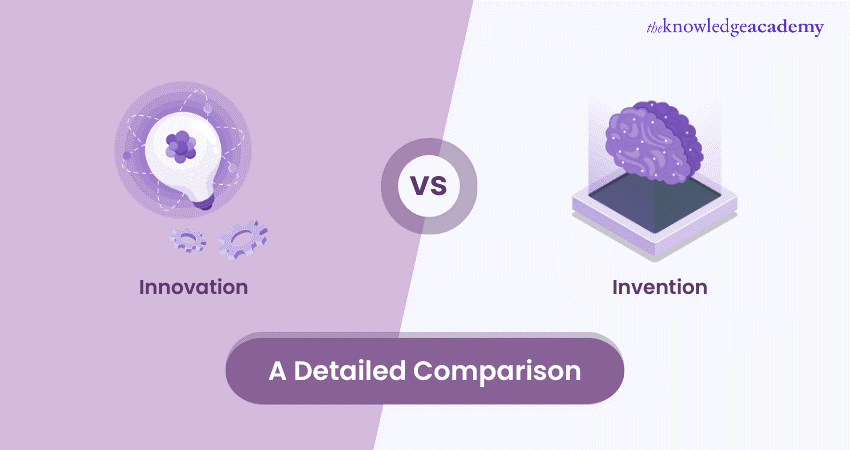When discussing progress, creativity, and technological evolution, the terms “innovation” and “invention” are often used interchangeably. However, these two concepts are not the same. While they are closely related and often overlap in the real world, they represent distinct ideas with unique implications—especially for entrepreneurs, business strategists, inventors, and innovators.
Understanding the difference between invention and innovation is essential if you want to navigate the modern world of startups, patents, product development, or even strategic growth in an organization. In this detailed guide, we will explore the definitions, key differences, real-life examples, and why knowing the contrast matters more than ever in today’s competitive landscape.
A. Defining Invention and Innovation
To begin our comparison, let’s clearly define both terms:
What Is Invention?
Invention refers to the creation of something entirely new that has never existed before. It can be a physical product, a process, a method, or even a unique idea. The key factor here is originality—something brought into existence through creativity or discovery.
Examples of invention include:
The lightbulb
The telephone
The airplane
Penicillin
All these were born out of raw experimentation or scientific exploration. An invention is typically the result of research and development (R&D) and may often be protected with patents.
What Is Innovation?
Innovation, on the other hand, refers to improving, applying, or commercializing ideas and technologies—whether newly invented or not. Innovation is about making things better, more accessible, more efficient, or more desirable for users.
Examples of innovation include:
Apple’s iPhone combining various existing technologies into one sleek device
Uber leveraging GPS, mobile apps, and ride-sharing to disrupt transportation
Netflix transforming movie rentals into a streaming service
In essence, innovation turns ideas into impact.
B. Key Differences Between Innovation and Invention
Although they may sound similar, several critical distinctions set them apart:
1. Nature of the Idea
Invention: Typically brings something into existence that didn’t exist before.
Innovation: May build upon or improve existing inventions or processes.
2. Goal and Purpose
Invention: Driven by curiosity, scientific exploration, or problem-solving.
Innovation: Driven by market needs, user demand, or business growth.
3. Stage of Development
Invention: Usually occurs at the early stage—raw idea or prototype.
Innovation: Focuses on implementation, scaling, or commercialization.
4. Risk and Uncertainty
Invention: High technical risk, often with uncertain commercial value.
Innovation: Focuses on usability and value creation with known elements.
5. Market Relevance
Invention: May not immediately serve a market need.
Innovation: Is designed to meet demand and often generates revenue.
C. Real-World Examples of Invention vs Innovation
To make things more tangible, let’s explore some well-known examples:
Example A: The Personal Computer
Invention: The first computers in the 1940s and 50s were massive machines invented for military and academic use.
Innovation: Steve Jobs and Apple made them personal, portable, and user-friendly—transforming society.
Example B: The Internet
Invention: The ARPANET was a government-funded project to share data across universities.
Innovation: Tim Berners-Lee introduced the World Wide Web, making the internet accessible to everyone, laying the foundation for e-commerce and social media.
Example C: Electric Vehicles
Invention: The first electric vehicles existed as early as the 1800s.
Innovation: Tesla revolutionized the market by solving charging infrastructure and performance issues, making EVs mainstream.
D. Types of Innovation
Innovation is a broader concept with several types:
A. Incremental Innovation
Improving existing products or services in small, manageable steps.
Example: Regular updates to smartphone software or car models.
B. Disruptive Innovation
Introduces a new way of doing things that displaces traditional models.
Example: Airbnb replacing hotel stays for millions of travelers.
C. Radical Innovation
A leap that creates a new market or changes the rules entirely.
Example: The first digital camera, which reshaped photography forever.
D. Process Innovation
Optimizing how something is done rather than what is done.
Example: Amazon’s warehouse automation reducing delivery times.
E. Why Innovation Matters More Than Invention in Business
While inventions are impressive, innovation is what drives profit, market relevance, and growth. Here’s why innovation is often prioritized in modern business:
A. Commercialization
An invention without a market is just an idea. Innovation ensures that the idea is useful and valuable to customers.
B. Customer-Centric Approach
Innovation listens to market feedback and adapts accordingly. It keeps users at the center of development.
C. Competitive Advantage
Companies that innovate frequently stay ahead in the market, while those stuck in traditional ways risk becoming obsolete.
D. Scalability
While inventions may start in labs, innovation makes them scalable—accessible, affordable, and widespread.
F. Can You Have One Without the Other?
Yes—but with limitations.
You can invent something but fail to innovate, which means the idea never reaches mass adoption.
You can innovate without inventing, by taking existing products and making them better or more accessible.
For example:
Henry Ford didn’t invent the car but innovated mass production through the assembly line.
Facebook didn’t invent social networking but scaled it globally through innovative engagement models.
The ideal scenario is when invention and innovation work together—bringing something new into the world and making it usable, profitable, and impactful.
G. The Legal Side: Patents and Intellectual Property
One way to distinguish invention from innovation is through legal protections:
A. Inventions
Usually qualify for patents, granting exclusive rights to the inventor for a period of time.
B. Innovations
May or may not be patentable. Instead, innovation often involves trade secrets, user experience, business models, or branding strategies.
Protecting an invention legally doesn’t guarantee success. What matters more is how it is brought to market—and that’s where innovation shines.
H. How to Foster Invention and Innovation in Organizations
A business that wants to stay relevant must nurture both invention and innovation.
A. Invest in R&D
Create dedicated resources for scientific and exploratory research.
B. Encourage Creative Thinking
Give employees time and freedom to experiment without fear of failure.
C. Support Prototyping and Testing
Fast-track ideas from concept to testing through iterative feedback loops.
D. Promote Cross-Functional Teams
Innovation often happens when different disciplines collide—engineering with design, marketing with data science.
E. Stay Close to Customers
Innovation thrives on understanding real needs and iterating based on user feedback.
I. Educational and Career Relevance
Understanding the difference between invention and innovation is vital across fields:
Students: Learn how creativity fits into science, business, or engineering.
Entrepreneurs: Decide whether to invest in building something new or improving what’s already out there.
Corporate Leaders: Balance visionary inventions with innovation that aligns with the company’s goals.
Knowing when to invent and when to innovate can be the difference between building a revolutionary idea—or creating one that actually survives the market.
Invention and innovation are both essential for progress—but they serve different purposes.
Invention gives us the raw potential of new ideas.
Innovation ensures those ideas are useful, scalable, and sustainable.
Whether you’re a tech startup founder, a student of design, or a corporate strategist, embracing both invention and innovation allows you to not only dream big but also execute with impact.
Remember: Invention is the spark, innovation is the fuel.















